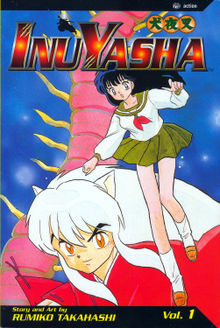
List of InuYasha chapters
Encyclopedia

Manga
Manga is the Japanese word for "comics" and consists of comics and print cartoons . In the West, the term "manga" has been appropriated to refer specifically to comics created in Japan, or by Japanese authors, in the Japanese language and conforming to the style developed in Japan in the late 19th...
series InuYasha
InuYasha
, also known as , is a Japanese manga series written and illustrated by Rumiko Takahashi. It premiered in Weekly Shōnen Sunday on November 13, 1996 and concluded on June 18, 2008...
were written and illustrated by Rumiko Takahashi
Rumiko Takahashi
is a Japanese manga artist.Takahashi is one of the wealthiest individuals, and the most affluent manga artists in Japan. The manga she creates are popular worldwide, where they have been translated into a variety of languages...
and serialized in Shonen Sunday
Shonen Sunday
, first published on March 17, 1959, is a weekly shōnen manga magazine published in Japan by Shogakukan. Contrary to its title, Weekly Shōnen Sunday issues are released on Wednesdays.- History :...
, premiering on November 13, 1996 and ending on June 18, 2008. The 558 chapters have been collected into 56 bound volumes
Tankobon
, with a literal meaning close to "independently appearing book", is the Japanese term for a book that is complete in itself and is not part of a series , though the manga industry uses it for volumes which may be in a series...
by Shogakukan
Shogakukan
is a Japanese publisher of dictionaries, literature, manga, non-fiction, DVDs, and other media in Japan.Shogakukan founded Shueisha which founded Hakusensha. These are three separate companies, but are together called the Hitotsubashi Group, one of the largest publishing groups in Japan...
, which released the first volume in May 1997.
Viz Media
VIZ Media
VIZ Media, LLC, headquartered in San Francisco, is an anime, manga, and Japanese entertainment company. It was founded in 1986 as VIZ LLC. In 2005, VIZ LLC and ShoPro Entertainment merged to form the current VIZ Media LLC, which is jointly owned by Japanese publishers Shogakukan and Shueisha, and...
licensed the series for an English translated release in North America. Initially, Viz released it in monthly American comic book
American comic book
An American comic book is a small magazine originating in the United States and containing a narrative in the form of comics. Since 1975 the dimensions have standardized at 6 5/8" x 10 ¼" , down from 6 ¾" x 10 ¼" in the Silver Age, although larger formats appeared in the past...
format (page size 17x26cm, or 6⅝×10¼") under the title "Inu-Yasha[sic]: A Feudal Fairy Tale" with each individual issue containing two or three chapters from the original manga, but eventually abandoned this system in favor of collected volumes in trade paperback format, using the same chapter divisions as the Japanese volumes.
The first-edition series of Viz trade paperbacks retained the same title and subtitle but reduced the page size to approximately ISO A5 dimensions
Paper size
Many paper size standards conventions have existed at different times and in different countries. Today there is one widespread international ISO standard and a localised standard used in North America . The paper sizes affect writing paper, stationery, cards, and some printed documents...
(14.5x22.5 cm, or 5⅝x8⅞"). After volume 12, the first-edition A5 series was discontinued. Subsequently, Viz issued new volumes and reprints of older volumes in the "Action Edition" second-edition format, with the simple title "InuYasha" and slightly smaller pages (12.8x19cm, or 5x7½").
Viz released the first 37 volumes on a quarterly schedule, mirror-imaging the artwork to a "flipped" left-to-right format as standard in English-language works, as opposed to the right-to-left reading direction of Japanese. Volume 1 was released on July 6, 1998; volume 37 was released on April 14, 2009.
On April 22, 2009, Viz announced that future volumes would be released in an unflipped format on a monthly schedule, starting with volume 38 in July 2009. However, reprints of the first 37 volumes have remained "flipped" instead of being reflipped back to right-to-left.
In November 2009, Viz began to issue a third-edition set of paperbacks in their "VizBig" format, with three of the original volumes combined into each omnibus. These restore the page dimensions to the slightly larger size of the first-edition paperbacks, and also faithfully reproduce the occasional full-color bonus pages that were reduced to grayscale
Grayscale
In photography and computing, a grayscale or greyscale digital image is an image in which the value of each pixel is a single sample, that is, it carries only intensity information...
in previous printings.
Viz Media also releases a separate series of "ani-manga" derived from full-color screenshots of the anime
Anime
is the Japanese abbreviated pronunciation of "animation". The definition sometimes changes depending on the context. In English-speaking countries, the term most commonly refers to Japanese animated cartoons....
episodes, with dialogue and sound effects added in. These volumes are slightly smaller than the regular manga volumes, are oriented in the Japanese convention of right to left, feature new covers with higher quality pages, and are sold at a higher price point versus the regular volumes. Each ani-manga volume is arranged into chapters that correspond to the anime episodes rather than to the manga.
The chapter numbers listed below refer to the overall placement within the series. The Viz reprints have used several different renumbering systems; in the ongoing second-edition collections, the first chapter of each volume is indexed as "Scroll One", the second chapter is "Scroll Two", and so on, with the numbering reverting to "Scroll One" at the start of each new volume.
Volume list
Note: Viz's official English-translated titles through volume 48, unofficial Japanese translations thereafter.Volumes 1–20
Volumes 21–40
Volumes 41–56
External links
- Interview with English translator

